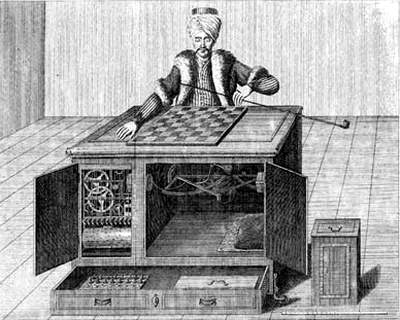A LOOK AT THE INSIDE (27 january 2007)
From time to time, you can see chess games here played by computers. A few of my readers have complained about this. "I'm not interested in chess games", they say.
I can imagine chess games are not everybody's cup of tea. But with one of the largest collections of chess computers on the Internet, it would be silly never to write about them.
When asked what they would like to see instead, I heard someone say he would like to see what a chess computer looks like on the inside.
But the person who said this, may have imagined a kind of 'computer' like the 18th century conjuring trick called The Turk, whose inside was specially designed to impress the spectators.
 "The Turk"
"The Turk"
The innards of present-day chess computers don't, however, look very exciting.
From time to time, computers tend to break down. Yesterday the post brought me a replacement for such a broken specimen. This made it possible for me to take the old computer apart and show you what's inside. The computer looks like this:
Excalibur Touch Chess
When we turn the computer around, we can open the battery compartment, which is secured with two long screws:
very long screws
When the screws have been taken out, you can slide the lid open and you'll see three button cell batteries:
three button cells
Now we can loosen the four screws that keep the computer closed and lo and behold: there is the interior:
computer is open
The lonely metal disk on the lid is a loudspeaker. On the right there is a black wheel, which is used to adjust the contrast of the screen. And on the far side of the computer, you can see the "stylus", the pen with which the screen can be pressed.
Here is the mainboard shown a little closer:
mainboard, front
The three parts (from left to right) are:
- the "ACL switch", a thin metal disc which can be pushed with a paperclip or so through a hole in the lid. It is used to reset the computer.
- a capacitor (orange-coloured), which is part of the 'clock'
- a 'crystal', the part of the clock that determines how fast it 'ticks'.
This computer uses a single-chip processor (ROM, RAM and the processor itself in one chip). This chip is mounted on the other side of the main board, so we'll have to unscrew this board:
mainboard,
back
Once the board has been unscrewed, it can be turned around. We can see that the processor -- like a spider in its web -- controls about a hundred wires. Unfortunately, the processor itself is invisible, since the manufacturer has covered it with some black material.
Manufacturers are not exactly generous with information about processors, but if you want to see what the interior of a typical processor looks like, here is a picture (taken of a completely different one):
 typical processor
typical processor
You may have expected to find out how chess computers work. Unlike bicycles, pencil sharpeners and clocks, the innards of a chess computer do not really disclose how the computer works.
But perhaps that's a good subject for a future weblog ...